tri-met max light rail (1992-2000)
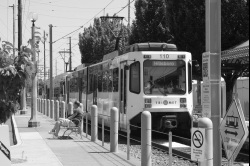
We worked with two premier consulting firms in Portland to provide Tri-Met with the necessary drawings for the Hillsboro Extension and the Interstate MAX LRT Projects. These projects included the following typical drawings:
- Survey Control
- Site Layout
- Utility Drawings
- Track Alignment
- Park and Ride Design
- Station Design & Details
- Traffic Signalization
- Pedestrian Crossings
- Electrification Design and Detail
- Lighting Design
- Landscape Design
west side cso tunnel project (2003-2005)
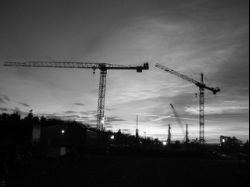
The City of Portland broke ground on the West Side Big Pipe in November 2002 on Swan Island and completed construction in September 2006, more than two months ahead of schedule.
West Side Big Pipe
Swan Island Pump Station
Tunnel Access Shafts
Southwest Parallel Interceptor
Peninsular Force Main
West Side Big Pipe
- 14-feet in diameter, 3.5-miles long, 120-feet deep
- Runs beneath Waterfront Park and crosses under the Willamette River to Swan Island
- Built by two tunnel-boring machines, one tunneling north from the Nicolai Shaft to Swan Island, the other tunneling south from the Nicolai Shaft to the Clay Street Shaft
Swan Island Pump Station
- 160 feet deep with an inside diameter of 124 feet
- Pumps sewage from the West Side Big Pipe, and will pump sewage from the East Side Big Pipe, through force mains to the Columbia Boulevard Wastewater Treatment Plant
- Pumping capacity of 220 million gallons per day
- Pump station site includes an odor control facility and isolation gate structure
Tunnel Access Shafts
- Four large access shafts on the west side of the Willamette River and a confluent shaft on Swan Island
- Main mining shaft at Northwest Front and Nicolai was 55 feet in diameter and 120 feet deep
- Tunnel access shafts also at NW Northrup Street, SW Ankeny Street and SW Clay Street
Southwest Parallel Interceptor
- Extends nearly three miles from the intersection of Southwest Taylors Ferry Road and Virginia Avenue to Clay Street
- Ranges in size from 36-inches on the south end to 72-inches where it connects to the West Side Big Pipe at Clay Street
Peninsular Force Main
- Pressure line moves sewage from the Swan Island Pump Station to an existing sewer tunnel near North Greeley Street and North Going Street
- 5,000 feet long consisting of two parallel pipes, 30-inches and 48-inches in diameter
sandy river conduit relocation (2008-2009)
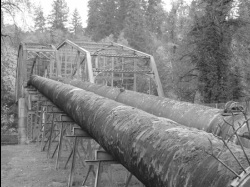
Bull Run watershed provides water to the City of Portland. Water is transferred through a two pin-truss steel pipeline bridge, which was constructed in 1893. Due to damage caused by sediment as well as security concerns, the City is relocating water conveyance conduits below ground. Kiewit Pacific Co., a subsidiary of Kiewit Corporation, is constructing the Sandy River Conduit Relocation project. This design-build project involves taking the two existing above ground conduits and placing them in a 441-linear-foot tunnel under the Sandy River The scope of work includes a 30-foot-diameter construction shaft to a depth of 85 feet; two drilled 9-foot-diameter shafts to a depth of 110 feet and a 13-foot-diameter modified horseshoe tunnel running diagonally under the girth of the Sandy River. Before completion of all shafts, the tunnel will be backfilled with cell grout and the site will be restored. A series of trenches will be placed at the surface, connecting the existing pipes to new underground conduits. Once the conduits have been diverted to the new underground tunnel, the current pipe bridge will be dismantled and hauled off-site.
Usually the Bureau completes the project design before it hires a contractor to build the project. However, SRX was the first time a “design-build” contract was issued. A team fielded by Kiewit Pacific Co. led the design and construction for the $21 million project.
Usually the Bureau completes the project design before it hires a contractor to build the project. However, SRX was the first time a “design-build” contract was issued. A team fielded by Kiewit Pacific Co. led the design and construction for the $21 million project.
east side cso tunnel project (2006-2012)
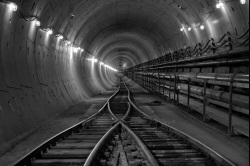
The City of Portland broke ground on the East Side Big Pipe project in 2006. It is the largest sewer construction project in Portland history. The $464 million East Side Big Pipe was the last in a series of projects dating back to 1991 to control combined sewer overflows (CSOs) to the Columbia Slough and Willamette River.
The joint venture Kiewit-Bilfinger Berger (KBB) was the city's contractor on the East Side Big Pipe Project. KBB used a 300-foot long tunnel boring machine with a 25-foot diameter cutter head to construct the nearly 6-mile long tunnel. The tunnel parallels the east bank of the Willamette River from SE 17th and McLoughlin to Swan Island at an average depth of 150 feet. The interior of the finished East Side Big Pipe is 22 feet in diameter.
The machine began mining in June 2007 at the Opera Shaft near the Portland Opera Building on SE Water Avenue, which is also the East Side Big Pipe Project construction headquarters. The tunnel boring machine reached Swan Island to complete the north drive in October 2009.
The project contractor removed the machine from a tunnel shaft on Swan Island and barged the machine upriver back to the Opera Shaft to begin its south drive to a tunnel shaft at SE 17th and McLoughlin. The tunnel boring machine completed tunneling in October 2010 and the city activated the East Side Big Pipe in fall 2011.
The project included construction of seven tunnel access shafts, new connecting pipelines and the Portsmouth Force Main, which will convey sewage from the Swan Island Pump Station to the Columbia Boulevard Wastewater Treatment Plant.
The joint venture Kiewit-Bilfinger Berger (KBB) was the city's contractor on the East Side Big Pipe Project. KBB used a 300-foot long tunnel boring machine with a 25-foot diameter cutter head to construct the nearly 6-mile long tunnel. The tunnel parallels the east bank of the Willamette River from SE 17th and McLoughlin to Swan Island at an average depth of 150 feet. The interior of the finished East Side Big Pipe is 22 feet in diameter.
The machine began mining in June 2007 at the Opera Shaft near the Portland Opera Building on SE Water Avenue, which is also the East Side Big Pipe Project construction headquarters. The tunnel boring machine reached Swan Island to complete the north drive in October 2009.
The project contractor removed the machine from a tunnel shaft on Swan Island and barged the machine upriver back to the Opera Shaft to begin its south drive to a tunnel shaft at SE 17th and McLoughlin. The tunnel boring machine completed tunneling in October 2010 and the city activated the East Side Big Pipe in fall 2011.
The project included construction of seven tunnel access shafts, new connecting pipelines and the Portsmouth Force Main, which will convey sewage from the Swan Island Pump Station to the Columbia Boulevard Wastewater Treatment Plant.
U830 university link light rail project (2012-2016)
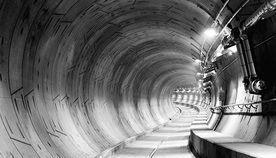
University Link Extension: The University Link Extension work program with $1.76 billion capital budget was approved by the Board in July 2008. The 3.15-mile light rail segment is located entirely underground with tunnels traveling from Pine Street, under I-5 freeway to an underground station at Capital Hill, continuing north beneath SR 520 and the Lake Washington Ship Canal to an underground station on the University of Washington campus, near Husky Stadium. Revenue Service is projected in the 1st QTR 2016.